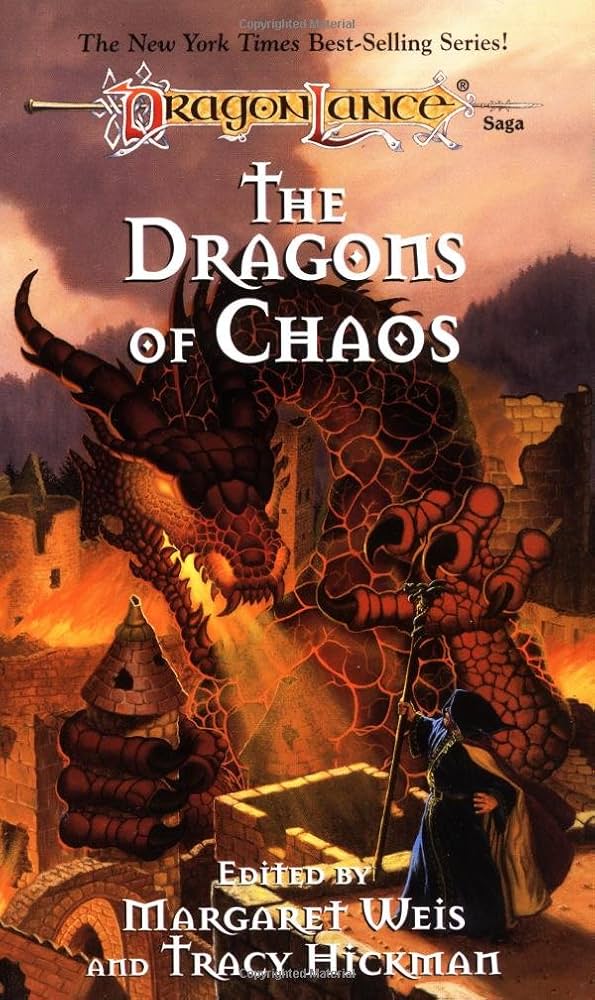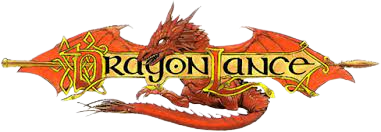The Dragons of Chaos

Table of Contents
ToggleOverview
The Dragons of Chaos is a short story anthology that explores the role of dragons during the Age of Mortals and the Chaos War, when the gods had departed, magic had changed, and Krynn was in cosmic upheaval. It’s part of a trio of themed anthologies (along with The Dragons of Krynn and The Dragons at War) that explore different aspects of dragons in Dragonlance.
This volume focuses on the strangeness and instability of the post-cataclysmic world—when the Graygem of Gargath, the Primordial Chaos, and the departure of the gods had reshaped the laws of nature and magic. The dragons in these stories are often weird, powerful, alien, or emotionally unstable—mirroring the world they inhabit.
Purpose and Structure
The anthology’s goals are to:
- Highlight the evolving role of dragons during the Chaos War and its aftermath
- Explore dragons reacting to cosmic changes, magic flux, and godless existence
- Feature a mix of metallic, chromatic, and even chaotic dragons
- Offer surreal, tragic, and sometimes unsettling stories of transformation, despair, and hope
Each story is self-contained, but most are set in or around the Age of Mortals, when old alliances, magic, and faith have crumbled.
Notable Stories and Summaries
1. “The Dragon’s Eye” by Nancy Varian Berberick
A metaphysical tale about a dragon who is slowly losing her mind as the boundaries between time and space blur. She begins seeing visions of events that haven’t happened—or have already happened in alternate timelines. A brilliant dive into chaos-as-reality-distortion.
2. “The Magnificent” by Douglas Niles
Follows a red dragon with delusions of grandeur who tries to recreate old glories during a time when dragons are no longer universally feared. It’s both tragic and ironic—highlighting how dragons, too, are victims of changing eras.
3. “Kaz and the Dragon’s Children” by Richard Knaak
Set long after the famous Legend of Huma, this tale features Kaz the Minotaur meeting a new kind of threat: a dragonborn cult born of chaos. It explores legacy, myth, and how old heroes face the future.
4. “Aurora’s Eggs” by Janet Pack
A metallic dragon goes on a surreal and harrowing journey to recover her stolen clutch of eggs—only to find that the Chaos-touched world has mutated them into something strange and dangerous. Part horror, part maternal tragedy.
5. “The Lost Dragons” by Michael and Teri Williams
A poignant story about dragons who refuse to pick sides in mortal wars and retreat to a timeless plane—only to learn that escape from chaos is impossible. It raises questions about neutrality and moral disengagement.
6. “The Final Flight of Kitiara Uth Matar” by Rick Knaak (reprint)
Though previously published, this story fits thematically as it explores the spiritual remnants of Kitiara and her ties to a spectral blue dragon. Chaos here is psychological and afterlife-oriented—symbolic of unfinished legacies.
Themes
Madness and Mutation – Many dragons in these stories are driven mad by the unraveling of natural laws, the shifting of magic, and the absence of divine guidance. Some mutate physically; others mentally.
Legacy in a Changing World – Dragons, like mortals, struggle with irrelevance in the post-cataclysm world. Many tales explore how they cling to old roles or fail to adapt.
Chaos as Transformation – The dragons here are often symbols of change, whether for better or worse. Their powers, instincts, and philosophies are warped by chaos.
Isolation and Loss – A surprising number of stories deal with lonely dragons—estranged from their kind, misunderstood, or left behind by a changing world.
Cosmic Horror and Magic Instability – Several stories explore the idea of reality itself breaking down—dragons perceiving or embodying eldritch or chaotic truths.
Tone & Style
The Dragons of Chaos is easily the most surreal and experimental of the three main Dragonlance dragon anthologies. Its stories are:
- Emotionally heavier
- Stylistically more ambitious, with stream-of-consciousness, non-linear timelines, and dreamlike sequences
- Symbolic, especially in how dragons represent eras, emotions, or divine absence
If The Dragons of Krynn is mythic, and The Dragons at War is martial, then The Dragons of Chaos is existential fantasy.
Reception
This anthology is a favorite among readers who enjoy dark, thoughtful fantasy. Highlights include:
- Unique takes on dragons as more than monsters or allies
- Philosophical and metaphysical themes
- Complex emotional arcs, especially among dragons themselves
However, some readers find the tone too abstract or too removed from traditional Dragonlance action. It’s a collection best suited to fans of character-driven, cerebral fantasy, not readers looking for epic battles or quests.
Final Thoughts
The Dragons of Chaos is a moody, experimental, and highly literary entry in the Dragonlance saga. It explores dragons not as beasts or gods—but as beings caught in the same whirlwind of cosmic change as mortals, trying (and often failing) to find meaning in chaos.
Highly recommended for:
- Readers intrigued by chaos magic, altered reality, and emotional depth
- Fans of non-traditional dragon stories
- Long-time Dragonlance readers who want to see the weirder corners of Krynn’s lore
